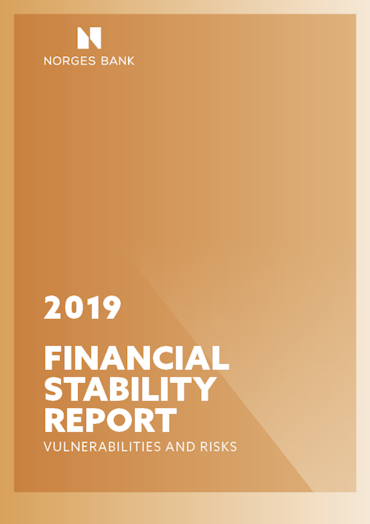Financial Stability Report 2019: vulnerabilities and risks
Read the report (web edition)- Series:
- Financial Stability Report
- Number:
- 2019
Financial Stability Report 2019 in a nutshell
The financial system must be able to absorb serious shocks
Banks are essential to the economy and perform important tasks for society. Financial stability implies that banks and the rest of the financial system are able to perform these tasks adequately, even in the event of serious downturns and economic crises.
High debt levels and high property prices are the primary vulnerabilities
High household debt levels and high property prices are the key financial system vulnerabilities in Norway. In Norges Bank’s assessment, these vulnerabilities have changed little over the past year, although debt growth and property price inflation have slowed.
Risk of shocks from abroad
Global uncertainties, especially related to trade tensions and the UK’s relationship with the EU, pose risks to financial stability in Norway. Turbulence abroad can spread to Norway and be amplified by vulnerabilities in the domestic financial system.
Measures by the authorities are mitigating household vulnerabilities
Requirements for banks’ credit standards limit excessive borrowing by the most vulnerable households. Norges Bank is of the view that these requirements have functioned as intended and supports continuation of the regulation on new residential mortgage loans.
Norwegian banks are resilient
Norwegian banks are currently profitable, solvent and have ample access to funding. The stress test in this year’s Report shows that banks may still amplify a downturn by tightening lending. To counter this, the authorities can lower the countercyclical capital buffer and allow banks to draw on the other buffers.
The financial system is also affected by climate risks
Climate change and measures to mitigate climate change may result in losses and funding problems for banks. This entails risks to financial stability, which is why it is important for the financial sector to include climate risks in overall risk assessments.

In its bi-annual Financial Stability Report, Norges Bank assesses the financial stability outlook. The Report discusses cyclical and structural developments in financial markets, the Norwegian economy, banks and other financial institutions. Assessments of the countercyclical capital buffer and other recommendations for measures to safeguard financial stability are made on the basis of vulnerabilities, risks and resilience in the financial system. See all Financial stability reports
ISSN 1503-8858 (online).